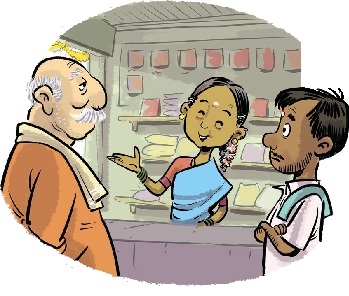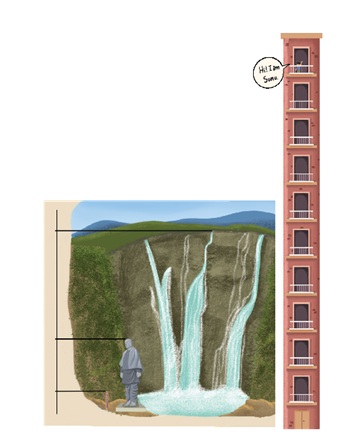1.1 A Lakh Varieties - NCERT class 7 maths Textbook - Ganita prakash
1.1 A Lakh of Varieties!
“Screen Readable NCERT Class 7 Mathematics Textbook – Ganita Prakash – for Blind and Visually Impaired Students prepared by Professor T K Bansal.”
Eshwarappa is a farmer in Chintamani, a town in Karnataka. He visits the market regularly to buy seeds for his rice field. During one such visit, he overheard a conversation between Ramanna and Lakshmamma.
Figure 1.1

Ramanna said, “Earlier, our country had about lakh of varieties of rice. Farmers used to preserve different varieties of seeds and use them to grow rice of different varieties. Now, we only have a handful of varieties. Moreover, farmers have to come to the market to buy seeds”.
Lakshmamma said, “There is a seed bank near my house. So far, they have collected about a hundred indigenous varieties of rice seeds from different places. You can also buy seeds from there.”
You may have heard the word lakh (लाख in Hindi) earlier. Do you know how big one lakh is? Let us find it out.
Eshwarappa shared this incident with his daughter Roxie, and with his son Estu.
Figure 1.2

Estu was surprised to know that there were about one lakh varieties of rice in our country. He wondered, “One lakh! So far, I have tasted only 3 varieties of rice. If we tried a new variety each day, would we even come close to tasting all the varieties of rice even in a lifetime of 100 years?”
Figure 1.3

What do you think? Guess.
But how much is one lakh? Observe the pattern and fill in the □ given in the below table.
(a)
| Serial Number |
Question | Box | 1 | The Largest 3-digit number is | 999 |
|---|---|---|
| 2 | The smallest 4-digit number is | □ |
| 3 | The largest 4-digit number is | □ |
| 4 | The smallest 5-digit number is | □ |
| 5 | The largest 5-digit number is | □ |
| 6 | The smallest 6-digit number is | 100000 |
(b)
| Numbers in Increasing Order |
|---|
| 99995 |
| 99996 |
| □ |
| 99998 |
| □ |
| □ |
| □ |
| □ |
| □ |
| □ |
Roxie and Estu found that if they eat one variety of rice every day, they will come nowhere close to one lakh even in a lifetime!
Figure 1.4

Roxie suggests, “what if we eat 2 varieties of rice every day? Will we then be able to eat 1 lakh varieties of rice in 100 years?”
What if a person eats 3 varieties of rice every day? Will he be able to taste all the lakh varieties in a life-time of 100- year? Find out.
Estu said, ”If we ignore leap years, we know that there are 365 days in a year. If we live for Y years, the number of days in our lifetime will be 365 × Y."
Choose a number for y. How close to one lakh is the number of days in y years, for the y of your choice?
Exercise 1.1 - Figure it Out
Question 1.
According to the 2011 Census, the population of the town of Chintamani was about 75000. How much less than one lakh is 75000?
Question 2.
The estimated population of Chintamani in the year 2024 is 106000. How much more than one lakh is 106000?
Question 3.
By how much did the population of Chintamani increase from 2011 to 2024?
1.1.1 Getting a Feel of Large Numbers
You may have come across interesting facts like these :
•
The world’s tallest statue is the ‘Statue of Unity’ in Gujarat depicting Sardar Vallabhbhai Patel. Its height is about 180 meters.
•
Kunchikal waterfall in Karnataka is said to drop from a height of about 450 meters.
It is not always easy to get a sense of how big these measurements are. But we can get a better sense of their size when we compare them with something familiar to us. Let us see an example.
Look at the picture below. Somu is 1 meter tall. If each floor is about four times his height, what is the approximate height of the building?
Figure 1.5

Which is taller - The Statue of Unity or this building? How much taller?
We can see that the height of the Statue of Unity is close to 4 times the height of Somu’s building.
How much taller is the Kunchikal waterfall than Somu’s building?
How many floors should Somu’s building have to be as high as the waterfall?
1.1.2 Is One Lakh a Very Large Number?
Eshwarappa asked Roxie and Estu, “Is a lakh big or small?”
Figure 1.6

Roxie feels that 1 lakh is a large number:
•
“We had one lakh varieties of rice - that is a lot.”
•
“Living 1 lakh days would mean living for 274 years - that is a really long time!”
•
“If 1 lakh people stood shoulder to shoulder in a line they could stretch as far as 38 kilometers.”
Figure 1.7

Estu, however, thinks it is not that big:
•
“Do you know that the cricket stadium in Ahmedabad has a seating capacity of more than 1 lakh? One lakh people in such a small area!”
•
“Most humans have 80000 to 120000 hairs on their heads. Imagine, 1 lakh hairs fit in such a tiny space!”
•
“I heard that there are some species of fish where a female fish lays almost one lakh eggs at once very comfortably. Some even lay tens of lakhs of eggs at a time.”
How do you view a lakh - is a lakh big or small?
1.1.3 Reading and Writing Numbers
We have already been using commas for 5-digit numbers like 45,830 in the Indian place value system. As numbers grow bigger, using commas helps in reading the numbers easily. We use a comma in between the digits representing the “ten-thousands” place and the “one-lakh” place as you have seen just before (1,00,000).
The number name of 12,78,830 is twelve-lakh seventy-eight thousand eight hundred thirty.
Similarly, the number 15,75,000 in words is fifteen-lakh seventy-five thousand.
Write each of the numbers given below in words:
(a) 3,00,600
(b) 5,04,085
(c) 27,30,000
(d) 70,53,138
Write the corresponding number in the Indian place value system for each of the following:
(a) One lakh twenty-three thousand four hundred and fifty-six
(b) Four lakh seven thousand seven hundred and four
(c) Fifty lakh five thousand and fifty
(d) Ten lakh two hundred and thirty-five
Note to the Teacher:
Encourage students to make connections between these facts. For example, can the whole population of Chintamani fit in the stadium? How can we imagine the line of 38 km, having a lakh people, sitting next to each other in the stadium?
